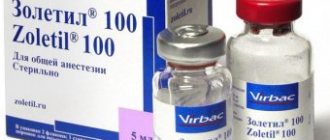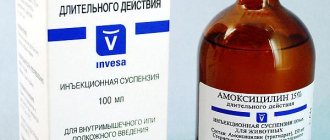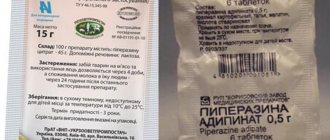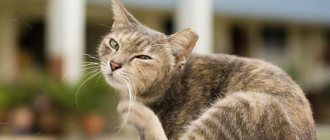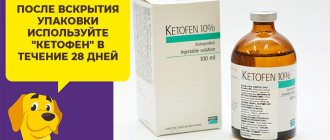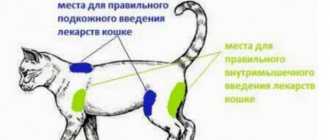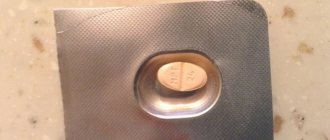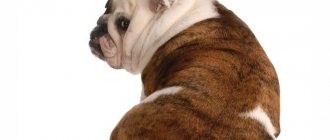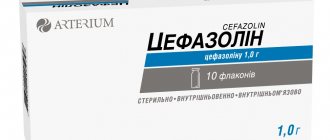Neostomozan is a broad-spectrum drug. Effective in the fight against many ectoparasites. It is used not only for treating animals, but also for premises. The presence of a pet in the home is associated with a high risk of fleas. Neostomozan allows you to get rid of them quickly, and without requiring large financial expenditures.
The product is available in the form of a concentrated emulsion. Before use, it is necessary to prepare a solution in the dosage specified in the instructions. The concentrate is diluted immediately before use, maximum within 2 hours after opening the bottle and preparing the solution. Otherwise, after 2 hours , the drug will lose its properties.
The active ingredients are synthetic insecticides.
- Tetramethrin 0.5%
- Transmix 0.5%
Excipients in the drug enhance the active ingredients.
Neostomazan is packaged in various containers:
- There are ampoules for treating animals, 2 and 5 ml.
- Bottles of 200 ml.
- Large canisters from 1 to 5 liters for indoor use.
It is actively used in preventive measures to exterminate fleas in animals. The drug has a contact mechanism of action. Upon contact with the substance, insects receive a dose of deadly poison. The drug blocks the transmission of nerve impulses in the insect's body, disrupting the functioning of the nervous system, which leads to the death of the parasite.
When treating an apartment, the drug can even cope with flea larvae. Efficiency is achieved due to the diverse action of the drug. At the same time, it is necessary to treat the pet if it lives indoors.
Composition and effect of the drug
The product is available in the form of a concentrated emulsion. Before use, prepare a solution in the dosage specified in the instructions. The concentrate must be diluted immediately before use, or at least within 2 hours after preparing the solution. Under other circumstances of use, the drug loses its effectiveness.
The active components are new generation synthetic insecticides:
Excipients enhance the effect of the main ones.
Neostomazan is packaged in containers of different capacities:
- ampoules for treating animals, 2 ml, 5 ml;
- bottles with a volume of 200 ml;
- canisters from 1 to 5 liters for room treatment.
Can be used for preventive purposes against fleas in animals. The action of the drug Neostomazan is contact. When harmful insects come into contact with it, the latter receive a dose of poison, which leads to the destruction of the membranes of nerve cells. The drug blocks nerve impulses and disrupts the functioning of the peripheral nervous system. Fleas experience paralysis, then death. Using the drug when treating an apartment allows you to cope with larvae that live independently of adult fleas. Efficiency is achieved through versatile action. At the same time, the animals, the premises where they live, the sleeping place, and the apartment are processed.
Indications for use and mechanism of action
The product is used for prevention against fleas, ticks, lice, lice, blood suckers, zoophilic flies, bedbugs, ants and other parasites.
The drug is poisonous to parasites. Upon contact with neostomosan, the insect’s nervous system is disrupted (the conduction of nerve impulses is blocked) and the parasite dies.
When used correctly, neostomozan has no effect on animal health. It has a detrimental effect on fish and bees.
Neostomozan is also suitable for cats. When disinfesting premises, the product is also harmful to insect larvae.
It is recommended to carry out a one-time treatment of the dog and its home.
Treating animals against fleas and ticks
The effect of the drug Neostomazan is aimed at most harmful insects. By treating it against fleas, you can protect it from ticks, lice eaters, and other parasites. The product is deadly to insects, safe for warm-blooded animals and people, provided it is used correctly. To treat animals, use ampoules with a capacity of 2 ml, 5 ml. Before use, you must prepare a solution. To dilute the concentrate, use water at room temperature. To treat cats and small dogs, 1–2 ml of concentrate is sufficient. To treat dogs weighing over 20 kg, 5 ml is used. The solution is prepared according to the dosage. 1 ml. Neostomazan is diluted in 200 ml of water. Therefore, to dilute 5 ml you will need 1 liter of liquid.
Animals can be treated using a sponge or a container with a spray bottle. In the first case, the wool is well moistened and a little rubbed into the skin. In the second case, spray the product onto the fur, moving it apart against the growth of hairs. The entire composition will be evenly distributed on the surface of the coat within 20 minutes.
- It is prohibited to pet the animal within 48 hours after treatment;
- to prevent Neostomazan from entering the stomach by licking it from the fur, it is recommended to wear a muzzle for half an hour during treatment and after it;
- You can bathe your pet only after 2 days, limit the use of soap products;
- Animals must be treated in the fresh air;
- hands must be protected with rubber gloves, the body - with a protective suit with long sleeves and trousers;
- If several animals are being processed at the same time, limit their contact while the wool is drying.
The next treatment of animals against harmful insects is carried out no earlier than 10 days.
Cats
Neostomozan helps get rid of lice, fleas, scabies, ixodid mites, and mosquitoes. The solution is prepared in a ratio of 1 ml of concentrate per 200 ml of water. The drug should be moistened with the animal's fur by bathing or spraying. In the latter case, use a spray bottle. Lice, fleas, and ticks die within an hour. A single treatment protects the cat from re-infection for 3 days. Treatment against scabies mites is repeated at intervals of 10 days until the test result is negative twice. When treating otodectosis, the solution is poured into the auricle and both ears are treated.
Dogs
The drug is used to combat lice eaters, fleas, scabies, ixodid mites, as well as flies and mosquitoes. To prepare a solution, 1 ml of Neostomozan is added to 200 ml of water at room temperature. The amount of the finished solution is calculated based on the size of the dog and the length of its coat. Treated by bathing and spraying. The spray is applied until the coat is completely moistened. Within an hour the parasites die. The protection is valid for another 3 days. Repeat the course if necessary after 7-10 days.
Pigs
The instructions for use are extremely simple. Dissolve 1 ml of the drug in 1 liter of water and stir thoroughly. Pour into a spray bottle and spray the animal's body. After 2 weeks, repeat the procedure.
Cows
Cattle are processed outdoors. 1 liter of the prepared solution is consumed per animal. Concentration – 1 ml of the drug per 1-1.5 liters of cold water. If scabies mites are present, the treatment is repeated after 7 days. Neostomozan is used in the same way for horses.
Read also: Mushroom caviar recipe
To treat a goat, prepare a solution at a concentration of 1 ml per 1 liter of liquid. Spray the animal's fur until completely moistened. About 1 liter of the finished product is consumed per adult animal. If necessary, the procedure is repeated after 10 days.
Rabbits
The drug is used to treat ear scabies. 1 ml of concentrate is diluted in 1 liter of water. To treat one ear, 1.5 ml of the finished product is required. Pour into the auricle. Repeat the procedure every 7 days until complete recovery.
To treat poultry against fleas, ticks, and other parasites, use a solution prepared in the proportion of 1 ml of the drug per 1 liter of cold water. The chickens are thoroughly sprayed until the feathers are completely moistened. After 7-10 days, the procedure is repeated.
It is prohibited to handle sick, weakened, or convalescent animals. Meat can be eaten if more than 5 days have passed after processing; milk can be drunk 3 days after disinfestation.
Neostomozan, fl. 1l
1. GENERAL INFORMATION. 1.1. Neostomosan. 1.2. Neostomozan is an insectoacaricidal drug in the form of a concentrated solution for external use, containing transmix (ß-cypermethrin) -5 g and tetramethrin -0.5 g in 100 ml. 1.3. Neostomozan is a non-separating transparent solution of yellow or yellow-brown color with a characteristic odor. 1.4. Neostomozan is produced packaged in plastic bottles or canisters of 1 and 5 liters, as well as in glass bottles of 200 ml or ampoules of 2 and 5 ml. 1.5. Store the medicinal product in tightly closed original packaging, in a dry non-residential area under lock and key, separately from food and feed, away from heating devices and open fire, in a place protected from light at a temperature from plus 5 °C to plus 25 °C. The shelf life of the medicinal product, subject to storage conditions, is 3 years from the date of manufacture, after the first opening of the package - 6 months, the finished working solution - 24 hours.
2. PHARMACOLOGICAL PROPERTIES. 2.1. Transmix and tetramethrin, which are part of neostomozan®, are synthetic pyrethroids, the mechanism of action of which is to block the conduction of nerve impulses by changing the permeability of membranes to sodium ions, which leads to irreversible paralysis and death of parasites. Synthetic rethroids are contact-acting agents that are active against sarcoptic, ixodid, and demodectic ticks; lice, fleas, lice-eaters, blood-sucking insects (mosquitoes, gadflies, midges, biting midges, bloodsuckers, etc.) and zoophilic flies. 2.2. The drug acts as a neurotoxin on the central and peripheral nervous systems of arthropods and, in recommended dilutions, is completely harmless to warm-blooded animals.
3. ORDER OF APPLICATION. 3.1. Neostomozan is used to combat ectoparasites of cattle, sheep, pigs, horses, dogs, as well as to kill flies in livestock and utility buildings. 3.2. Neostomozan is used in the form of an emulsion, which is formed after it is added to water. The working emulsion is prepared immediately before use. At the same time, the volume of aqueous emulsion required for processing and the amount of medicinal product required for its preparation are determined. A working emulsion diluted 1:1000 is prepared at the rate of 1 liter of neostomosan per 1000 liters of water. To prepare a working emulsion of 1:200, add 5 ml of neostomosan to each 1 liter of water. When preparing large volumes of working emulsion, the calculated amount of neostomozan is thoroughly mixed with 10-20 liters of water, and then, after the formation of a stable emulsion, poured into a sprayer tank or a floating bath, water is added to the required volume and mixed thoroughly. An aqueous emulsion of neostomozan is prepared in containers not intended for food purposes. Animals are treated outdoors at a temperature not lower than 18ºС or in well-ventilated rooms with open windows. 3.3. Before mass treatment of animals, each batch of the drug is tested on a small group (10-15) of animals of varying fatness. If the animals do not show signs of toxicosis within 2 days after treatment, they begin to treat the entire livestock. 3.4. For the treatment and prevention of sheep psoroptosis, the fight against ixodid ticks and other blood-sucking arthropods, neostomozan in a dilution of 1:1000 is used by bathing in a floating bath, or spraying at a rate of 1-2 liters per shorn sheep and 2-3 liters per unshorn sheep. Swimming exposure is 60 seconds. To maintain the required concentration after bathing 200 unshorn or 400 shorn sheep, add water to the bath to the original level and neostomozan at the rate of 100 ml for every newly added 100 liters of water. After bathing 3,000 sheep, the remaining emulsion is poured into settling wells, preventing environmental pollution, the bath is cleaned of dirt and filled with newly prepared emulsion. Sheep suffering from psoroptosis are treated twice with an interval of 7-10 days; those suspected of having the disease are treated once. Treatments against ixodid ticks and insects are carried out once, repeated treatments are carried out according to indications, but not more than once every 10 days. Sheep are processed in dry weather at a temperature of the cupping emulsion in the bath of 20-25ºС. After treatment, sheep should remain for 1-2 hours on a special platform to drain the emulsion. It is not recommended to treat lambs in swimming baths after weaning together with ewes. In farms affected by sheep psoroptosis, livestock premises are treated in the absence of animals with an aqueous emulsion of neostomozan (1:1000) by watering or irrigation with a consumption rate of 300-400 ml/m2 of the treated surface. Cattle and horses affected by insects, ixodid and sarcoptoid ticks are sprayed with an aqueous emulsion of neostomosan at a dilution of 1:1000. When spraying, it is necessary to moisturize the entire body of the animal, especially carefully treat areas in the area of the ears, limbs, belly and tail. The consumption rate of the working emulsion, depending on the weight of the animal, is 10 ml/kg, but not more than 4 liters per animal. Repeated treatment for entomosis and damage to animals by ixodid ticks is carried out according to indications, for sarcopticosis - twice with an interval of 7 days. Pigs with sarcoptic mange and hematopinosis are sprayed with a working emulsion of neostomosan at a dilution of 1:1000 with a consumption rate of 3 ml/kg, but not more than 300 ml per animal. Treatment is carried out twice with an interval of 7-10 days. At the same time, neostomozan working emulsion at a dilution of 1:1000 is used to treat surfaces in rooms in the absence of animals with a consumption rate of 300-400 ml/m2, where pigs are kept. Dogs with entomosis (lice, fleas, lice) and sarcoptoidosis are treated with a sponge, thoroughly wetting the entire surface of the body with neostomosan emulsion at a dilution of 1:200 with a consumption rate of 10 ml/kg for long-haired breeds, 5 ml/kg of animal weight for short-haired breeds. It is not recommended to treat puppies less than 2 months old. For entomosis, treatment is carried out according to indications, but not more often than once every 7 days; for sarcoptoidosis - twice with an interval of 7-10 days. In order to prevent flea breeding and reinfestation, the animals' bedding is replaced or treated on the reverse side with a working emulsion of neostomozan, and then washed with detergent. To combat flies in feed kitchens, dispensaries, artificial insemination points, pens for keeping newborn calves, on farms and fattening complexes for cattle and pigs, fur farms, stud farms and other veterinary supervision facilities, neostomozan in a dilution of 1:1000 is used in the absence of animals by fine-droplet application on surfaces (walls, ceilings, equipment) with a consumption rate of 60-80 ml/m2. At the end of the treatment, the room is kept closed for 1-1.5 hours, after which the windows and doors are opened and ventilated for 30 minutes. Dead flies are swept away and disposed of. Feeders and drinking bowls are thoroughly washed with a slightly alkaline soda solution, and then introduced into the animals’ premises. Repeated treatments of premises are carried out according to indications. In summer camps, flies are destroyed by selectively applying a water emulsion to the internal and external surfaces of walls, sheds, pens and other places where insects are localized. In case of an overdose of the drug, symptoms of a central nervous system disorder may be observed: salivation, weakness of the hind limbs, tremor, loss of coordination of movements. In this case, it is recommended to stop treating the animal, wash off any remaining drug with plenty of running water and soap, and carry out symptomatic therapy. 3.5. Side effect. There are no side effects when used in recommended doses. As a rule, there are no side effects or complications when using the drug in accordance with these instructions. If an animal develops allergic reactions to the components of the drug, stop using it. 3.6. Contraindications. It is prohibited to use neostomozan® simultaneously with other insecticides. Neostomozan® is contraindicated for use in dairy horses and sheep, as well as in post-weaned lambs, puppies less than 2 months old and cats. It is prohibited to treat patients with infectious diseases and exhausted animals. 3.7. Precautionary measures. Avoid contact of the drug with the eyes or skin. The working solution must be used within 24 hours after preparation. The drug is toxic to fish and bees. It is prohibited to pour the drug into open bodies of water (ponds, canals, streams). Used drug containers are prohibited from being used for household purposes. The active ingredient is completely destroyed within 48 hours. 3.8. Waiting time: 0 days.
4. PERSONAL PREVENTION MEASURES 4.1. When working with neostomozan®, you should follow the general rules of personal hygiene and safety precautions provided for when working with medicinal products for animals. 4.2. All work with neostomozan® should be carried out using special clothing and personal protective equipment (gown, headgear, dust goggles, rubber gloves, rubberized apron, rubber boots, respirator (type RU-60M or RPG-67 with cartridge A). Working solution of neostomozan ® should be prepared only in the open air. During work, it is prohibited to eat, drink or smoke. When processing animals in livestock buildings, ensure intensive ventilation. Avoid contact of children with the treated animal until the latter is completely dry. Processing dogs and cats should be carried out only in rubber gloves. After work, the overalls must be removed, the face and hands should be washed with warm water and soap, and the mouth should be rinsed. 4.3. If neostomozan® gets on the skin or mucous membranes, it is washed off with a stream of water or carefully removed with a swab and then washed with water or a slightly alkaline solution. If neostomozan® entered the body through the mouth, the victim should be given several glasses of warm water with two teaspoons (tablets) of activated carbon or other adsorbent. If workers show signs of poisoning (dizziness, general weakness, nausea), they must stop work, take off their overalls, wash their face and hands, and contact a medical professional. Empty drug containers must not be used for household purposes; they must be disposed of with household waste.
5. PROCEDURE FOR SUBMISSION OF COMPLAINTS 5.1. If complications arise after using the drug, its use is stopped and the consumer contacts the State Veterinary Institution in whose territory it is located. Veterinary specialists of this institution are studying compliance with all rules for the use of the drug in accordance with the instructions. When confirming the identification of a negative effect of the drug on the animal’s body, veterinary specialists take samples in the required quantity for laboratory testing, write a sampling report and send it to the State Institution “Belarusian State Veterinary Center” (220005, Minsk, Krasnaya St., 19a) to confirm compliance with regulatory documents.
6. FULL NAME prepared by the veterinarian of the representative office of JSC “Ceva Sante Animale” in the Republic of Belarus (France) Svilovich V.V. (220035, Minsk, Chekhova str., 3, room 1N, tel./fax +375 (17) 306-40-14).
Treating the room where the animal lives for fleas
Dogs can live in the house or in a special kennel near it. If a pet runs freely in a person’s home, the entire apartment or house will have to be treated. Living in a separate booth makes everything much easier. The solution is prepared in accordance with the size of the booth. Usually 5 ml of concentrate per 1 liter of water is enough. The mixture is stirred well for 15 minutes. Pour into a spray bottle or container with a spray bottle. Particular attention is paid to the litter. If it is made of fabric, it should be treated and washed in hot water after 30 minutes. To prevent re-infection of the pet and the premises, a flea treatment is carried out once a month.
To treat premises, a solution is prepared in a ratio of 5 ml of the drug per 1 liter of water. The quantity is calculated based on the area. The consumption of the finished product on a hard surface is 50 ml/sq.m. m. This means is used for disinfestation in pigsties, cowsheds, flocks, and chicken coops.
At the time of processing, animals are removed from the premises. Thoroughly spray walls, window sills, ceilings, and floors. After 2 hours, remove the bedding, wash the feeders with an alkaline solution with laundry soap, baking soda, and ventilate. Animals are allowed to be released on the same day after cleaning. The protective properties last for about a week.
Premises treatment
Pets can live both in houses and in various kinds of enclosures and kennels. If an animal moves freely outside, or has contact with other animals, it can pick up parasites. To treat your pet’s home, you need to dilute a solution of 5 ml in 1 liter of water. The mixture is mixed well for 15 minutes.
After which it is poured into an empty container and sprayed into the home. Particular attention should be paid to the area where the animal sleeps. It is advisable to wash the bedding in hot water. The procedure is repeated after 1 month.
When treating an apartment, the amount of solution is calculated based on the area of the room. To treat an apartment for the purpose of prevention, one liter of solution will be enough. To treat a large area, you can use 2 or more liters of solution, which is diluted according to the old proportions. It is also worth considering the surface; soft tissue uses twice as much of the drug as hard tissue.
It is advisable to treat the apartment using a spray bottle. You need to start from your pet’s sleeping place, thoroughly treat the rug and floor. You should take into account the fact that fleas can live under the floor, in cracks and crevices. When applying the product using a spray bottle, keep it at a distance of no higher than 20 centimeters from the floor.
Treating your apartment against fleas
The amount of solution depends on the area of the room and the purpose of the procedure. When treating an apartment against harmful insects for the purpose of prevention, 1 liter of solution and 5 ml of concentrated Neotomazan are sufficient. To treat a large area to get rid of fleas, you may need 2 liters of solution with 10 ml of concentrate. When treating an apartment, surfaces should be taken into account. On soft, fabric, with pile, 2 times more solution is consumed. The prepared solution of Neostomozan is poured into a spray bottle.
The destruction of fleas begins with disinfestation of the pet's sleeping area. Spray the rug and floor well. When treating an apartment, you should take into account that fleas live under the floor, in cracks in the wall. But they rise no higher than 1 m from the floor surface. The spray bottle must be held at arm's length. There should be about 20 cm to the surface.
The second important point in treating the room is the larvae. They look different and live separately from adults. They hide in a pet's rug, near the toilet, under boxes of vegetables, or a trash can. All this must be processed without fail. After this, destruction is carried out along the entire perimeter of the room - floor, furniture, walls, baseboards, doorways.
Maximum time should be devoted to processing the premises, since the final result depends on the thoroughness of the destruction. After the procedure, it is necessary to ventilate the room for 3 hours. You should enter it only after this time has passed. Carry out wet cleaning in places where hands may touch. General restoration of order should be carried out 3 weeks after the complete destruction of parasites.
Repeated disinsection is carried out after 10–14 days. The concentration of Neostomozan can be reduced. Dilute 5 ml per 3 liters of water.
Instructions for use of Neostomozan
Neostomozan is a yellow liquid concentrate that requires appropriate dilution. For processing industrial premises and large apartments, canisters with a volume of 1 or 5 liters are usually used.
The prepared solution can be used to treat premises contaminated with ectoparasites and the animals themselves, both agricultural and domestic. The composition is a flammable chemical compound and requires appropriate safe handling.
Pets are treated using a sponge. If necessary, re-process. For long-haired breeds, the emulsion consumption is 10 ml/kg of weight, for short-haired breeds - 2 times less. Neostomozan for dogs is also applied to the back of the animal's bedding, and after 2-3 days the bedding is washed.
- Treatment of premises is carried out in the absence of animals in them.
- Children cannot contact pets until the drug has dried on their fur.
- Processing should be carried out in such a way that the chemical composition does not get on dishes and food.
- At the end of the treatment, the premises are closed for 1 hour. Then open the windows and doors and allow for 30 minutes of ventilation. Insect corpses are removed with a vacuum cleaner, followed by wet cleaning of all surfaces.
How to dilute neostomozan?
Treatment of an apartment against fleas with neostomosis begins with the preparation of a working solution. To do this, the liquid concentrate is diluted with water at room temperature, resulting in an emulsion that is used within 24 hours.
When diluted, the suspension is stirred. To prepare it, use a special container.
When preparing a working suspension in a ratio of 1:200, take 5 ml of the product and dilute it in 1000 ml of water.
If there is a need to prepare large volumes, prepare a solution in a ratio of 1:1000, for which you can use a 1-liter canister and add the appropriate volume of water, a thousand times greater than the volume of the product.
Reviews about the drug neostomozan
“The drug neostomozan for cats turned out to be very smelly and toxic. Our cat almost had a heart attack. She and I were tired. Then they found out that there were pyrethroids, unacceptable poisons for cats. No one at the veterinary pharmacy warned about this. On the contrary, they advised. So check with your veterinarian again before you buy, although the composition is cheap.” Vasily Ivanovich, Ryazan
Analogs
Neostomozan is an analogue of the drug Neogard, and in the absence of one of them, you can safely replace it with the second. Active components of Neogard transmix, tetramethrin. Refers to low-toxic substances. Used for treating animals and premises. Effective against fleas, lice, ticks, mosquitoes, flies. Used for the prevention and treatment of scabies. The solution is prepared in proportions of 1 ml of concentrate per 1 liter of water. Has a specific smell. Do not use on sick, weakened animals. The drug is difficult to find on sale.
Neostomozan is often replaced with Delcid. A domestically produced insectoacaricidal agent for treating animals against harmful insects and premises. The active component is the pyrethroid deltamethrin, the excipients are nefras, neonol, tween. Before use, dilute with water. For fleas, lice, ixodid ticks, midges, spray once; to treat scabies, repeat the procedure 2-3 times with a break of 7-10 days. To prevent cats and dogs from licking, put on a collar or tighten the jaws with braid for 20 minutes.
Read also: What to plant next to roses photo design
In addition, there are products on sale with similar effects, but with different active ingredients. You can buy the drug in a specialized store, veterinary pharmacy, or order online.
Precautionary measures
Carrying out disinfestation with Neostomozan against insects involves the use of personal protective equipment. Protect hands with rubber gloves, respiratory tract with a respirator, and skin on the body with clothing. After disinfestation against parasites, it is necessary to remove personal protective equipment, wash your hands with soap and wash.
Neostomazan has a specific, pungent, unpleasant odor. While working, you can take short breaks and go out into the fresh air. If dizziness, weakness, or headache occur, destruction must be stopped. Rinse your mouth with soda solution, take an activated carbon tablet.
In animals, the first time after using Neostomozan the following is observed:
- loss of appetite;
- drowsiness;
- apathy;
- weakness;
- increased salivation;
- lacrimation;
- redness of the skin.
Symptoms resolve within 3 days. If a severe allergic reaction occurs, you should take your pet to a veterinarian.
Customer Reviews
Dear readers! You can leave your feedback on the effectiveness of Neostomozan in the comments below, they will be useful to other users!
I used Neostomosan for cleaning floors. There are fleas under the parquet, there are no animals in the house. 1 liter of solution was enough. Very pungent smell. I washed it for 10 minutes in a respirator and rubber gloves. I went outside for 2 hours, then washed everything off well with soap and water. Removed parasites in one go. I can't argue with the effectiveness. But the smell was present for a long time!
I love cats very much. I sell kittens. I used this product for a while. Poisoned everyone. two teenage kittens could not be pumped out!
The product is very toxic. To treat dogs, I add a few drops to the shampoo. I bathe as usual. In this way we get rid of parasites and prevent their appearance. In this case, there are no side effects. I use the rest of the product to disinfect the room - I wash the floor and treat the dog’s sleeping area.
Release forms
Neostomozan is an emulsion with a broad spectrum effect. Under its influence, parasites experience disruption of the peripheral nervous system, blocking impulses coming from it. Insects experience paralysis and death. The drug contains components such as transmix, tetramethrin and fillers that enhance their effect (piperonyl butoxide, acetic anhydride, geronol FF/4/emulson AG/L, geronol FF/emulson AG/MS, paraffin oil, solvent - Solvesso 150ND / Solvarex 10 LN.).
An aqueous solution is prepared on the basis of neostomazan - 5 ml per 1 liter of water (for treating the animal’s sleeping place). Or 1 ml per 200 ml of water (enough for a cat). Stir the resulting liquid thoroughly; this should take at least 15-20 minutes. It is convenient to use a container (for example, a plastic bottle) with a spray bottle.
Struggle
Treatment of lice in chickens involves treating the birds with insecticides. It is better to use drug solutions by spraying the birds with them from a garden sprayer. The plumage should be evenly moistened.
Powders can also be used. They will have to be rubbed into the plumage of each chicken individually, while observing the recommended dosage. If possible, avoid getting the medicine in the eyes and nose.
When kept in cages, chickens are treated directly in the cages; when kept on the floor, they are sprayed on perches at night.
- 0.25% aqueous emulsion of cyodrine;
- 2% aqueous suspension of entobactrin;
- 5-7% Turingin (read the visitor’s review in detail in comment No. 3 on this page);
- 0.05% dibromine;
- 0.3-0.5% aqueous solution of chlorophos;
- 0.5% permethrin emulsion;
- 0.7% dicresyl;
- 0.3% solution of trichlorometaphos-3;
- butox, neostomozan (in ampoules or bottles) - 1 ml per 1 liter of water;
- pyrethrum – powder;
- 7% sevin powder – 15 g per head;
- aerosol "Ecofleece";
- deltamethrin powder.
The photo shows a jar of chlorophos, a technical, effective and inexpensive remedy for lice in a chicken coop.
These insect repellents can be purchased at your veterinary pharmacy. Pyrethrum is also sold in regular pharmacies.
Insecticide solutions are used in the same dosages as those recommended for washing pets. In small farms, as a last resort, you can use flea drops - “Clandestine”, “Dana”, “Bars”, “Beafar”, “Frontline” and others. They need to be applied to the skin of each chicken once according to the weight of the bird.
As for household insecticides (aerosols such as Dichlorvos), it is better to postpone their use. Firstly, they can be toxic to poultry, and secondly, they will have high consumption, which is a financial burden.
The treatment of the chicken coop is carried out simultaneously with the treatment of the birds. Anything that is not afraid of fire is burned with a blowtorch or gas torch. All surfaces and bedding are sprayed with insecticide solutions:
- 10% aqueous suspension of pyrethrum;
- 0.25% aqueous emulsion of sevin;
- 0.5% aqueous emulsion of karbofos;
- Neostomazan, butox diluted 1:200.
The most affordable means for treating the entire poultry house is karbofos.
Chickens must be removed from the premises during processing. After spraying, leave for several hours, and if possible 1-2 days. After exposure, change the bedding, wash the feeders and drinkers with water.
It makes sense to use such folk remedies in the fight against chicken lice only on small farms. However, in the conditions of private household plots they should not be neglected.
Mode of application
It is better to apply the product to the cat in the fresh air (at least on the balcony); according to reviews, it smells like kerosene; the person must wear personal protective equipment (goggles, gloves, a respirator) and long sleeves, trousers. It is necessary to take breaks during processing, as the strong odor can cause dizziness, nausea or weakness.
Use a sponge dipped in neostomazan or use a spray bottle to moisten the entire coat. If necessary and for uniform distribution, the hair is moved apart against its growth.
The scheme for treating a cat’s ears involves preliminary preparation of the inner surface of the hearing organs. Clean the surface with cotton swabs and disks, then drip 3 drops of neostomazan. The ear is pressed to the head and gentle massage movements are made with the hand so that the product is distributed inside. The outside also needs to be wiped with cotton wool soaked in the medicine. A week later the procedure is repeated. This event will rid your pet of ticks.
Rules to follow when using Neostomazan:
- Do not bathe or pet the cat for 2 days after disinfection;
- If the drug is sprayed on several animals, they should be isolated from each other while drying;
- Use a muzzle to prevent the animal from swallowing the medicine during treatment;
- After a 10-day interval, repeat the treatment of both the cats and the premises.
- Treat the animal's bedding thoroughly (carry out the process monthly): spray it with the product and also boil it. Treat the floor and nearby walls (up to a height of 1 m) with the preparation.
Animals, like humans, can be subject to side effects from the use of neostomazan. In addition to the above, the animal may have redness on the skin and lacrimation. If the symptoms that arise do not go away within 3 days, you need to show your pet to a veterinarian. When treating a room, you should close it for 3 hours, and only after the specified time go in and ventilate it.
The advantages of using neostomazan include price, effectiveness and ease of use. And the disadvantages are high toxicity (fish and bees may die).
The following safety measures will help avoid negative consequences:
- Working with the drug should not be combined with smoking, eating or drinking liquids.
- Neostomazan must be stored strictly in places out of reach of children or animals, separately from food products for animals or people.
- Do not use the drug after the expiration date (on average - at temperatures up to 25 degrees, 3 years).
- Do not dispose of unused solution of the drug into water bodies.
Flea
They have an oval slightly flat shape, dark brown color, size 1.5 mm and long hind legs.
It lives at temperatures of 40C and above, so it has no interest in humans and mammals. They often feed on exposed skin (near the eyes, legs and crest).
They lay eggs on the floor. The larvae feed on grass and chicken droppings, so the coop should be cleaned frequently to prevent fleas. They differ from other parasites in their ability to jump far.
With a small number of fleas, the symptoms in chickens are not as obvious as with other diseases. Birds constantly clean their feathers and gravitate towards dust baths. With a large number of insects, the bird becomes depressed, losing feathers and appetite.
Lice appear in chickens when living conditions deteriorate and when the bird comes into contact with infected individuals. Nervousness and scratching the affected area are the main symptoms of infection.
Lice feed and lay eggs on feathers, so small pits may be visible in the affected feather.
It is possible that the cause of lice was a change in diet, wet weather or decreased immunity. In any case, it is important not only to treat the birds and the chicken coop, but also to find out the main cause of the infection.
Note: lice are noticeably more common in roosters, since they clean their feathers less often and take ash-sand baths.
They are rare, have a length of 2-5mm and small wings. Color, depending on the species, varies from dark brown to red and yellow.
Bird bugs feed on blood and greatly affect the condition of chickens. They are also dangerous to humans. They usually hide in dark places, crevices, cracks, under feeders and nests.
Detection of infection with internal parasites is only possible by contacting a veterinarian. But if there are individuals in the chicken coop that lay eggs without shells, then there is a suspicion of infection with trematodes, which cause inflammation of the rectum in the bird.
Trematodes and other helminths cause intoxication of the chicken’s body, which, in turn, leads to a decrease in egg production, weight loss and death of the birds.
It is possible to get rid of chicken lice and fleas in a chicken coop by carrying out a set of measures. It is imperative to identify the external cause of the infestation and eliminate the source of insects entering the birdhouse. It is necessary to disinfect not only the surfaces of the poultry house, but also perches, nests and even feeders.
Specialized products are used as needed and to prevent infection of the chicken coop. At the same time, most owners of private farmsteads prefer no less effective products that they make themselves.
So a mixture of bleach and turpentine in a ratio of 1:4 reliably disinfects the air in the poultry house.
During the reaction, intense evaporation of the components occurs, and conditions are created that exclude the presence of insects in the room. Prevention is carried out once a week with intensive ventilation.
The veterinary drugs neostomazan, sevin or malaton will help against the down-eater. They have a low level of toxicity when used in the correct dosage. Chickens are treated with the prepared emulsion immediately after its preparation. It is enough to carry out two treatments within a week, but do not allow the drug to come into contact with the mucous membranes.
Down-eater larvae settle in cracks of wooden surfaces and can remain there, dormant, for up to 3 months. Whitewashing the walls with lime will help get rid of this scourge.
Treatment of the chicken coop from ticks is carried out as follows:
- Insectoacaricidal preparations (Sevin, Diazinon, Stomazan and others) are purchased;
- All cracks in the chicken coop are sealed;
- Ventilation is turned off if present;
- Mechanical cleaning of the chicken coop is carried out;
- Cracks in walls and perches are treated with a concentrated oil-based preparation;
- The prepared solution is sprayed on walls, ceilings, floors and equipment;
- After treatment, intensive ventilation of the room is carried out for 3-4 hours;
- Drinkers and feeders are washed.
To treat chickens for ticks, consult a veterinarian who can advise you on an effective commercially available insect control product.
VIDEO REVIEW » alt=»»>
If you use drops, ointments or gels against parasites, then each bird should be treated with these products separately. This method is suitable if you keep no more than 20-30 chickens and processing is not difficult.
The procedure should be carried out before disinfecting the chicken coop in the morning. When the chickens have woken up and are about to leave the premises, you can easily catch them one by one.
Usually the withers or neck are treated so that the chicken cannot reach this area with its beak and the product does not enter the digestive tract.
If you have a large farm, it is better to use powder products.
Substances that dissolve with water are also applied to the back using a rag or sprayer.
- Insecticides
Insecticides that are sold in veterinary pharmacies are suitable for treating the chicken coop. Many of them are safe for people and animals.
Get, Hartz, Karbofos, Cucaracha, Pyrethrum, Sevin Emulsion, Tetrix, Raptor aerosol, Karbofos emulsion, Tsifoks, Reid, Mashenka.
They are applied to the withers and just below the head so that the chicken does not reach with its beak and the drug does not enter the digestive system.
Dana, Celandine, Amidel, Neostomazan, Perol-A, Beafar, Bars, FrontLine, Stomazon.
Treating chickens against ticks with Butox should be done with extreme caution. These drugs are used on large poultry farms. The diluted solution is applied with a wet rag or spray to the withers, where the chicken cannot reach with its beak.
Fleas parasitize many species of warm-blooded animals and humans. Chickens are also attacked by these insects. In large poultry farms, parasites usually do not survive - this is due to the cyclical nature of production, good sanitary preparation of buildings and measures to prevent the introduction of infections and infestations into the farm.
But on small farms, fleas feel quite at ease.
Reviews
Reviews from owners about the drug indicate its effective antiparasitic effect:
- “The drug proved to be effective from the first use, I deviated a little from the instructions, but everything worked out the first time, I recommend it against fleas in cats!”
- “Neostomazan, indeed, a product of French quality. I liked its use not only on animals, but also on surfaces. One 5 ml ampoule was enough for a 4 kg cat and a 2-room apartment. There’s still more left!”
“Be sure to try neostomasan, it makes my Fanya’s fur shine! No fleas, after shaking the cat's fur, they dropped dead. Just get out of the house and then ventilate.”
